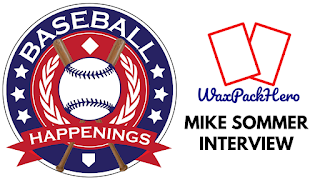Today's guest author is Bill Thompson from Words Above Replacement.
He shares how baseball cards opened the door to a deep love for the game that still runs strong today.
One Forgotten Detail
When discussing my baseball fandom, there is one critical element I often leave out. I’m not sure why; it’s an important part of my past. I will tell people over and over again the first time I went to Wrigley Field, the first time I heard Harry Caray, or that I realized I loved baseball by going games at Comiskey Park with my uncle. These stories roll off my tongue without hesitation; however, I rarely tell people that baseball cards most influenced my development as a baseball fan.
To this day I can recall going to the store and opening packs of cards. It didn’t matter whether it was Donruss, Topps, or anything in between (truthfully I was more partial to Upper Deck because their cards were always more colorful), I just wanted baseball cards. From the day I opened my first pack, I was hooked. From then on, I spent my money on three things—baseball cards, comic books, and pro wrestling.
There was no better feeling than walking up to the counter at Venture or K-Mart with a handful of packs and knowing I was about to discover more about baseball. The Chicago Cubs and White Sox were known quantities, but the rest of the Major League Baseball landscape was fleeting. My exposure consisted solely of the few days they spent on my television screen while playing one of the two Chicago ballclubs. Baseball cards were the only way I had, at the time, to learn more about the players.
A Trip Into Baseball's Past
Baseball cards were also a conduit to baseball history. I don’t remember the company, but I know early in my collecting life, one of them started including historical players in their packs. Years later, I can’t tell you who the players were, but I can tell you those cards led me to the library to seek out books on baseball history. Historical cards opened my eyes; there was more to baseball than what I could see in the present.
I mainly knew of MLB clubs in my early years. I was going to major market retailers for my packs, which meant I was only getting mainstream offerings. I knew there was a larger baseball world out there; prospect cards made that possible in my mind. Still, knowing Dwight Smith played for the Iowa Cubs didn’t prepare me for what was beyond MLB.
New Collecting Horizons
That all changed when the Venture I frequented suddenly had plastic packs exclusively of minor league cards. I bought as many as I could and dove headfirst into the world of Minor League Baseball. I returned to the library and looked for any books I could find that included the minors in their talks about MLB’s history.

By the mid-1990s, I had binders of baseball cards. They were organized by the team, not by the card company, or year. Talking to other card collectors, I soon realized everyone had their method of storing cards. My method was the correct one, or so I told myself whenever confronted with a different way. Around this time, I recall attending a Schaumburg Flyers game and convincing my uncle to buy me a pack of novelty Flyers cards; the world of unaffiliated baseball was thrust into my lap. I didn’t do much with this new world at first, but over time I used baseball cards as a way to keep track of unaffiliated leagues, teams, and players the best I could before the dawn of the Internet.
Meeting other collectors also took me down a path of self-discovery. For a few years, I thought I needed to have the biggest collection. I gave up pro wrestling and focused all my money on comic books and baseball cards.
An Unexpected Turn
Unfortunately, I also started to steal baseball cards, usually from Venture. I did this unabated for some time until I was finally caught. My obsession with baseball cards led to yet another important moment in my life. While I didn’t spend time in jail, or face any truly harsh consequences beyond a lifetime ban from Venture stores, I learned my actions carried a price. I discovered I didn’t like doing something blatantly illegal, and that having the most cards wasn’t a prize in and unto itself.
Years later, I wish I could tell you I still collect baseball cards. The truth is, I don’t, and my one attempt at getting back into the hobby was neither fruitful nor impactful. Baseball cards don’t play a role in my present-day life; however, baseball cards shaped my baseball fandom and the love I have for the game. Undoubtedly, without these small cardboard treasures, baseball would not have been an easy love affair. They helped me to grow as a fan and a person. While the cards are no longer physically in my possession, their influence is still profound in my heart today.





